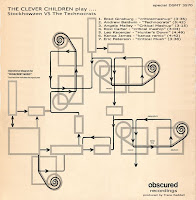Steve Reich's
Drumming, Pt.1 employs the technique of phasing, a kind of collaboration or transmission between two players (or a player paired with a recording) where one player preserves a static beat and the other follows along - miming, transcending and undermining the metronomic rhythm. A structure is generated from the first moment which expands, unwinding throughout the track, the two drums conversing in an exchange of time and action. Through this call and response, Reich maintains a consistent pattern for several minutes and then it breaks down, fragmenting the reply, withdrawing radically from established sound. "The underlying structure operates according to an additive process rather than either a traditional mode of representation or... abstraction" (McClary 295). One drum rolls up ahead up the beat, collapses on itself, and then returns and slows down, finally culminating in an ecstatic clamor. Reich's composition illustrates the divide between repetition and "the formalist excesses of High Modernism" (McClary 295) by providing a framework in which repetition and structural innovation can comment on each other, arriving at a kind of utopian trance in which all difference or disagreement is relieved.
To transmit - "to convey or communicate (usually something immaterial) to another or others... Also, to convey (force or movement) from one part of a body, or of mechanism, to another" (OED). Joy Division's
Transmission implores us to "Dance, dance, dance, dance, dance to the radio," invoking the electromagnetic wave of wireless telephony as well as the body's desire to reach another body through physical action.
Transmission reproduces through language the commentary on repetition and the new which
Drumming, Pt.1 performs -
And we would go on as though nothing was wrong.
And hide from these days we remained all alone.
Staying in the same place, just staying out the time.
Touching from a distance,
Further all the time.
The song presents dancing and listening to the radio as methods through which human interaction can become possible - the repetition of the mandate to "dance" acting as a reification of the "ecstatic structure of time in our moment" (McClary 295). Yet, unlike the visionary fervor which ends Reich's
Drumming, Pt.1,
Transmission laments the distance and loneliness embedded in the act of dancing to the radio, a kind of isolation which leads to abjection despite the possibilities which repetition opens up. The longing to connect is what animates both of these tracks, whether they are negotiated and absolved through rapture or resisted while still aching to close the gap.
Works CitedJoy Division.
Transmission. Factory, 1979.
McClary, Susan. "Rap, Minimalism, and Structures of Time in Late Twentieth-Century Culture."
Audio Culture: Readings in Modern Music. Ed. Cristpoph Cox and Daniel Warner. New York: Continuum, 2008.
Reich, Steve. Drumming, Pt. 1.
"transmit, v."
The Oxford English Dictionary. 2nd ed. 1989. OED Online. Oxford University Press. 12 Feb. 2010
.


